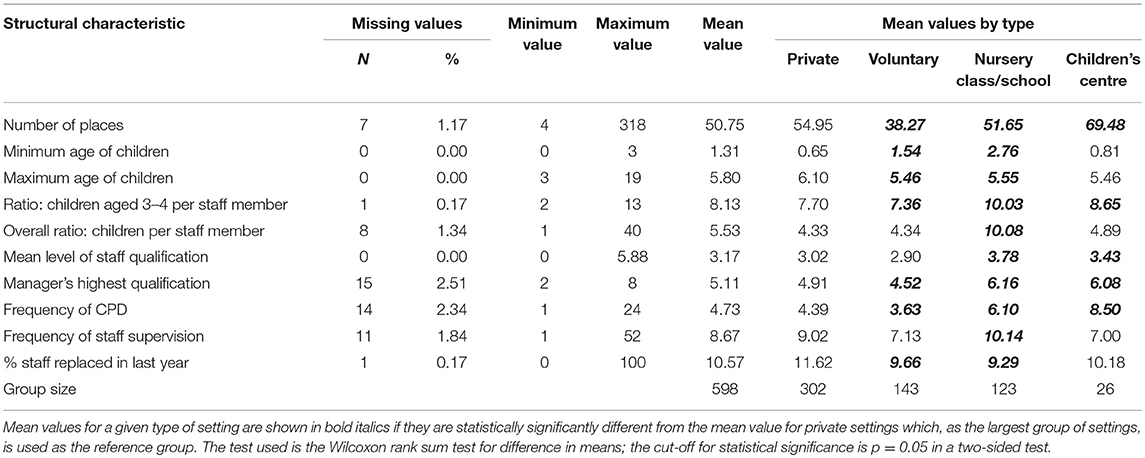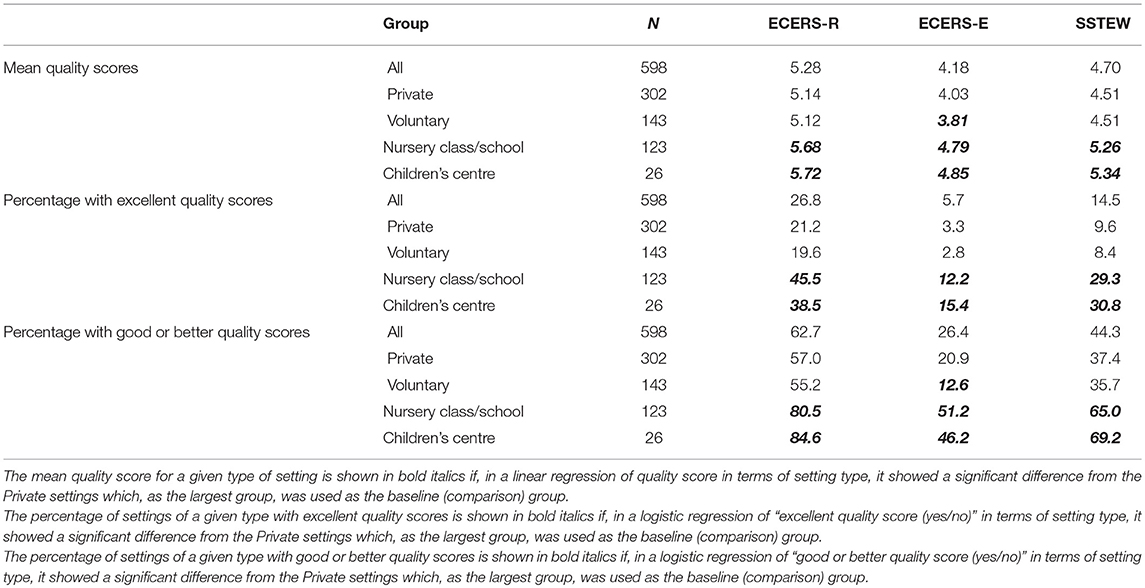- 1Department of Education, University of Oxford, Oxford, United Kingdom
- 2Department of Psychological Sciences, Birkbeck, University of London, London, United Kingdom
In many developed countries it is now the norm for preschool children to spend time outside the home in early childhood education and care (ECEC). Research indicates that attending ECEC can promote longer-term positive life outcomes, which is more likely when the ECEC is of higher quality. In a UK study of 600 ECEC group settings for 3–4 year olds, staff qualifications were predictive of quality at private (for profit) settings. For voluntary (not for profit) settings, which were more homogenous in staff qualifications, having a staff training plan and a better staff to child ratio were found to be significant predictors of quality. However, state funded nursery classes/schools, which tend to have less favorable staff to child ratios than private and voluntary settings, also tended to have higher process quality ratings, where the presence of more highly qualified staff apparently allowed quality to be maintained with a larger number of children per staff member. A comparison of equivalent quality data from separate UK studies, conducted before and after a period of substantial policy change in relation to ECEC quality, indicated that policy change may have powerful effects in improving ECEC quality with implications for long-term child, and potentially adult, well-being.
Introduction
Early Childhood Education and Care
In many developed countries it is now the norm for preschool children to spend time outside the home in early childhood education and care (ECEC). For instance, on average across OECD countries, 70% of 3-year-olds, 85% of 4-year-olds and 95% of 5-year-olds were enrolled in paid ECEC of some form (or primary education) in 2014 (OECD, 2017). In the UK much of this ECEC is in private (for profit), voluntary (not for profit) or state settings. State provision includes nursery classes attached to a school, or a nursery school catering specifically for pre-school children, with a small number of local authority nurseries, and also children's centres that combine ECEC provision with other services.
Research indicates that attending ECEC promotes school readiness and contributes to later school attainment and positive life outcomes into adolescence (Sylva et al., 2008; Melhuish et al., 2017). As well as affecting cognitive and educational outcomes, there is clear evidence that ECEC experience can have long-term consequences for socio-emotional development. In the USA, several studies evaluating programs with disadvantaged populations that use high quality ECEC as the intervention find positive effects on socio-emotional development. Barnett (2008) found that participation in the Early Head Start (EHS) program was associated with small improvements in children's behavioral problems (Sammons et al., 2002; Love et al., 2005) in terms of positive impacts on children's social-emotional development, including less aggressive behavior, more sustained attention, and higher engagement in play.
Two Domains of ECEC Quality
Two broad dimensions of quality have been identified that facilitate children's development and learning: structural quality (Early et al., 2007)—which includes adult-child ratios, staff qualifications, group size, and the characteristics of the physical space—and process quality (Slot et al., 2015)—which includes the quality of the curriculum, pedagogical practices and the quality of children's experiences that support development. Frequently there are relationships between structural characteristics and process quality; for example the Effective Provision of Pre-school Education (EPPE) study found that process quality was associated with the qualification level of ECEC staff (Sylva et al., 1999a; Melhuish et al., 2006) and the quality of early years provision has also been shown to be associated with managers' qualification level (Mathers et al., 2007; Roberts et al., 2010; Karemaker et al., 2011). In light of these findings, there has been support to improve the qualification level of ECEC staff in England, and there is evidence that it has indeed risen (Brind et al., 2014; Simon et al., 2016). This increase in qualifications may be related to improvements in quality ratings of preschool provision over time (Ofsted, 2015). Another structural characteristic that has been associated with better quality provision is higher staff to child ratios (Mathers et al., 2007; Roberts et al., 2010). For example, higher staff to child ratios have been associated with a higher quality of staff/child interactions in preschool settings (Karemaker et al., 2011). There is also evidence that type of setting may be associated with the quality of provision, for example two UK studies (Sylva et al., 1999b; Roberts et al., 2010) found higher quality in state-maintained settings.
It is likely that the relationships observed between aspects of structural quality and process quality are, at least to some extent, causal. We would therefore anticipate that changes to factors such as staff qualifications and training or staff to child ratios will ultimately affect the process quality of settings.
Research Aims
The aim of this research is to investigate the associations between structural and process quality measures at settings in the SEED study, and to explore the hypothesis that these relationships may vary according to the type of ECEC settings considered (e.g., private provision, state-funded provision). This research is of importance because, as discussed in the following section, the process quality of the ECEC which children attend may affect their educational and later life outcomes. An understanding of how structural quality influences process quality is therefore of use in developing more effective ECEC provision.
The Benefits of High Quality ECEC
It has been shown that positive benefits of ECEC are more likely if the ECEC experiences are of high quality. In studies of the general population, there is also evidence that the quality of the ECEC is important for children's future educational, cognitive and behavioral outcomes (Melhuish, 2004; Sylva et al., 2004, 2010; Barnes and Melhusih, 2016) all of which are relevant for subsequent mental health. Similarly, the high quality ECEC intervention in the Abecedarian Project (Muennig et al., 2011) was linked with long-term beneficial effects. Manning et al. (2010) in a meta-analysis showed reduced deviance, increased social participation, and reduced crime once children had reached adolescence. McLaughlin et al. (2007) showed that the early intervention reduced later depression, and Barnett (2008) reported that the Abecedarian program group reported fewer depressive symptoms and less substance abuse at age 21. Other evidence comes from less intensive intervention. A study conducted in Chicago (Reynolds et al., 2011) gives evidence of long term benefits for less advantaged children who started preschool aged three or four compared to those who started later. These benefits were larger for boys than for girls and were also larger among children whose parents did not complete high-school. When followed up at age 28, children who had started preschool aged three to four had higher levels of educational achievement, higher incomes and were less likely to have drug problems or involvement with crime, as compared to children who had started preschool at a later age. For example, in the Netherlands, Broekhuizen et al. (2014) found beneficial effects on behavior problems associated with higher quality of ECEC, which were also found in the UK (Sammons et al., 2002; Sylva et al., 2004). In the USA, research has indicated that higher ECEC quality (e.g., child-teacher relationships and interactions) can be prospectively related to more social competence and fewer behavioral problems (Peisner-Feinberg et al., 2001; NICHD Early Child Care Research Network, 2006; Burchinal et al., 2008; Mashburn et al., 2008), with some effects lasting into adolescence (Vandell et al., 2010). Studies have also demonstrated that children's behavioral self-regulation and emotional understanding can be improved by exposure to ECEC of high quality, specifically where there is a comprehensive socio-emotional curriculum and where staff development has focussed on the responsiveness of staff/child interactions (Bierman et al., 2014; Landry et al., 2014). This indicates that changing the quality of ECEC may enhance children's outcomes, including socio-emotional development.
The relevance of high quality ECEC is likely to differ depending on child characteristics. Studies have shown that exposure to ECEC of high quality can help to close the gap between levels of behavioral problems found in boys and girls, which generally tend to be higher in boys. Among disadvantaged children, it has been found that the level of behavioral problems in boys is reduced by exposure to high quality ECEC whilst the same exposure has much less effect on the levels of behavioral problems in girls (Votruba-Drzal et al., 2004, 2010). This may be in part because boys, who tend to have lower levels of self-regulation than girls, derive greater benefit from exposure to more structured environments (Votruba-Drzal et al., 2004, 2010). A study by Broekhuizen et al. (2015) explored whether children's emotional self-regulation and their gender were independent moderators of the effects of ECEC quality or whether the generally lower levels of emotional self-regulation among boys was a partial explanation for the moderating effect of child's gender. The study concluded that children's emotional self-regulation and their gender were independent moderating factors. This study also provides evidence for differences in the susceptibility of children to the effects of ECEC quality depending on their temperaments. Specifically, children with lower self-regulation show greater decreases in social abilities when exposed to low quality ECEC and also greater increases in social abilities when exposed to high quality ECEC, as compared to children with higher levels of self-regulation. This finding bears out earlier work by Belsky (1997). A similar pattern has been observed with regard to children's reactivity. Children with more reactive temperaments are both more likely than other children to exhibit behavioral problems when exposed to low quality ECEC and are also more likely to exhibit good levels of socio-emotional skills when exposed to high quality ECEC (Deynoot-Schaub and Riksen-Walraven, 2006; Pluess and Belsky, 2009; Almas et al., 2011; Phillips et al., 2012).
The Relevance of the Policy Context—Illustrated by the UK
In the UK, the period since 1999 has seen substantial policy developments for ECEC provision influenced extensively by research findings (Melhuish, 2016). Based on the established benefits of ECEC, successive UK government policies provided free ECEC provision for all 3–4 year olds in 2004 and undertook to improve the quality of provision through various measures, and have also extended funding for ECEC provision by increasing the number of hours funded and decreasing the age at which eligibility starts.
In 2017 provision was extended to 570 h annually for all 3–4 year olds, with an additional 570 h annually for children whose parents are working (Melhuish et al., 2017). From 2013 2 year old children from disadvantaged families (defined by the receipt of specific benefits) also became eligible for 570 annual hours of funded ECEC, and from 2015 this provision was extended to 2 year old children from households which were moderately disadvantaged, including children from families with low incomes and children with Special Educational Needs/Disabilities (SEN/D). This state provision of funding for ECEC for 2 year old children in the UK covers approximately the 40% most disadvantaged families by income.
The Statutory Framework for the Early Years Foundation Stage, which has legal foundations in the Childcare Act 2006, sets out statutory requirements for ECEC for children aged 0–5 in the UK with the aim of ensuring that all provision is of high quality so that “no child gets left behind” (Department for Education, 2014). The extent to which early years providers satisfy these requirements has been monitored by the Office for Standards in Education (Ofsted), since Ofsted began monitoring ECEC in 2001. In addition, there have been several government-funded schemes to improve quality of ECEC provision particularly from 2004 onwards, when state-funded universal provision started for 3 and 4 year olds.
This paper considers the relationship between structural and process aspects of quality in ECEC group settings for 3- and 4-year-old children from the Study of Early Education and Development (SEED) study, a large-scale ongoing longitudinal study in England that is investigating the potential impact of ECEC on children's outcomes in school and personal well-being. Then a comparison is presented between ECEC quality data from the SEED study collected in 2014–2016 and equivalent data from the Effective Provision of Pre-school Education (EPPE) study (Sylva et al., 2004, 2010). The EPPE study was conducted in six English local authority (LA) areas, chosen to provide coverage of urban and rural areas, more and less disadvantaged areas and to ensure ethnic diversity. Within each LA, centres were selected from the six most common types of provision: playgroups, local authority/voluntary day nurseries, private day nurseries, nursery schools, nursery classes, and integrated centres combining care and education. Centres were selected randomly within each type of provision in each LA. The sample consisted of 141 centres (Sylva et al., 2004).
The existence of these two large datasets on the quality of group ECEC in England, which are approximately nationally representative at their respective time points, enables a comparison before and after a period of extensive policy change that transformed the early years sector, and which was intended to increase both the uptake and quality of ECEC for children, particularly for those 3–5 years of age. This comparison can inform on whether policy change, as seen in the UK, is associated with change in ECEC quality. If so, then there is the possibility that there may be consequences for later child outcomes, including socio-emotional development and well-being, for the country's population. It may also be transferable to other contexts.
Strengths and Limitations
Strengths of this study are the large sample size, comprising 598 ECEC settings, and the wide range of settings type studied. ECEC settings are also included from all regions of England. A limitation of the study is that settings were chosen that were attended by children from the SEED study, which was highly clustered and in which disadvantaged children were over-represented. For this reason, although the SEED sample of settings is geographically diverse and includes settings of all main types, it is not a representative sample of all ECEC settings in England.
Methods
Sampling
As part of the SEED longitudinal study, a sample of 5,642 children born in England between September 2010 and August 2012 was selected using national child benefit records (state benefits available to parents with children). Sampling on the basis of geographical location (postcode districts) eligible families with children of the relevant age were selected for interview. This procedure produced a highly clustered sample. Children were selected according to family income so that approximately one third of the sample came from the most disadvantaged 20% of families by income, one third of the sample came from the next most disadvantaged 20% of families and one third of the sample came from the least disadvantaged 60% of families. A list of ECEC settings was obtained by asking parents which settings their children were attending as part of the SEED parent interviews. The sample was stratified by provider type, with settings classified as one of private, voluntary, state nursery class, nursery school, children's centre or local authority nurseries (LAN) (Melhuish and Gardiner, 2018).
Settings were selected so that the percentage in each category was similar to the percentage in that category across all settings used by children participating in the SEED study. If a provider did not wish to participate it was, wherever possible, replaced with the same type of provider from the same geographical area. The sample of ECEC settings came from all parts of England; it comprised 598 settings attended by children aged 3 to 4 participating in the SEED study.
Structural Quality
A staff interview was conducted with the manager of each childcare setting. During this structured interview a questionnaire was completed by the visiting researcher recording information on the structural quality of the ECEC setting provided by the setting manager. Information gathered comprised answers on the following topics: number of places at the setting, setting on single site/multiple sites, minimum age of children, maximum age of children, staff to child ratio, whether the settings had special educational needs and disability (SEN/D) provision, mean level of staff qualification, manager's highest qualification, whether the setting had a staff training plan, whether the setting had a staff training budget, frequency of staff continuing professional development (CPD), frequency of staff supervision and rate of staff turnover.
The overall staff to child ratio was calculated as the number of staff at a setting divided by the number of children at the setting, so higher ratios mean that there are fewer children per member of staff. The qualifications of ECEC staff and managers were recorded as equivalent to the following levels: Level 1 = GCSE (General certificate of secondary education; taken at age 16) D-G (lower level of pass), Level 2 = GCSE A*-C (higher level pass), Level 3 = A-Level (Advanced level examinations taken at age 18), Level 4 = Certificate of Higher Education (beyond age 18; lower level), Level 5 = Diploma of Higher Education (beyond age 18, higher level), Level 6 = Batchelor's degree, Level 7 = Master's degree, Level 8 = Doctorate.
Process Quality
Process quality was assessed by trained researchers during a half-day observational visit to each setting included in the study. Overall process quality for the settings attended by 3–4 year olds was assessed using the revised Early Childhood Environmental Rating Scale (ECERS-R) (Harms et al., 2005). This assessed settings quality using five domains: Space and Furnishings (e.g., room layout, accessibility of resources), Personal Care Routines (e.g., welfare requirements such as health & safety and provision for sleeping), Language and Reasoning (e.g., supporting children's communication, language and literacy development; supporting children's critical thinking), Activities (e.g., provision of an exciting and accessible learning environment, resources to support specific types of play), Interaction (e.g., supervision, support for social interactions) and Programme Structure (e.g., opportunities for children to access their own curriculum, planning schedules/routines to meet children's needs). The curriculum extension of the ECERS-R scale, ECERS-E (Sylva et al., 2011) was used to assess the specifically educational quality of the settings for 3–4 year olds; this consisted of the three domains: Literacy (e.g., opportunities for emergent writing, letters and sounds), Mathematics (e.g., number skills and reasoning) and Diversity (e.g., planning for children's individual learning needs, valuing and respecting other cultures, gender diversity). The quality of staff/child interactions was assessed using the Sustained Shared Thinking and Emotional Well-being scale (SSTEW) (Siraj et al., 2015) comprising five domains: Building Trust, Confidence and Independence (e.g., self-regulation and social development, encouraging choices and independent play, planning for small group, and individual interactions); Supporting and Extending Language and Communication (e.g., encouraging children to interact with others, staff actively listening to children, and encouraging children to listen, staff supporting children's language use); Supporting Emotional Well-being (staff supporting children's social and emotional communication); Supporting Learning and Critical Thinking (e.g., supporting curiosity and problem solving, encouraging sustained, shared thinking during story time, encouraging sustained, shared thinking in investigation, and exploration, supporting concept development and higher order thinking); and Assessing Learning and Language (e.g., using assessment to support and extend learning and critical thinking, assessing language development). For all three scales the total scale score was the mean of the subscale scores. The scores on the process quality scales had a range of 1–7. Quality was classified as Inadequate (<3), minimal (≥3 and <4), adequate (≥4 and <5), good (≥5 and <6) or excellent (≥6).
These measures were selected because they are commonly used in the UK and internationally to assess the quality of ECEC settings, they have high levels of inter-rater reliability (Clifford and Reszka, 2010; Whitebread et al., 2015), and they have been shown to capture key elements of settings quality. Quality assessed using these methods has also been shown to have some predictive value for the future outcomes of children attending ECEC settings (Sylva et al., 2010).
Analysis Strategy
Structural characteristics of settings and process quality were compared by provider type: private, voluntary, state nursery class/school, and children's centre (the number of local authority nurseries was small and these were omitted from comparisons). Means of the continuous measures were compared using the Wilcoxon rank sum test, while the proportions for binary characteristics—including whether or not process quality was “excellent” or “good or better”—were compared using the χ-square test for proportions.
The relationship between structural factors and process quality was examined using multiple linear regression of process quality measures as predicted by the structural characteristics of settings. Manager's highest qualification was omitted from the list of structural covariates because of potential collinearity with mean level of staff qualification. Factors associated with settings achieving “excellent”/“good or better” process quality were explored using logistic multiple regression models. Preliminary analysis showed that the relationships between structural characteristics and process quality differed by setting type; these regression models were therefore fitted separately for the different types of settings. For nursery classes/schools and children's centres the logistic regression models for “excellent” and “good or better” scores were not fitted as the sample sizes were too small to make these models reliable.
Comparing the Quality of ECEC Before and After Significant Policy Change
In order to examine how quality of ECEC provision has changed over time in England, this section compared data collected in 2015–2016 from the SEED study with data collected in 1998–1999 for the Effective Provision of Pre-School Education (EPPE) study (Sylva et al., 1999b). This enabled a comparison between the quality of ECEC settings before and after a period of rapid policy development in the area of ECEC, which occurred across the years 1999–2014 as described by Melhuish (2016). Both studies collected data on samples of settings that were approximately representative of ECEC group settings for 3–4 year old children in England at the relevant time. Both the EPPE (Sylva et al., 1999a) and SEED (Melhuish and Gardiner, 2018) studies included data collected by similar methodologies using the ECERS-R (Harms et al., 2005) and ECERS-E (Sylva et al., 2011) measures, as well as data on structural characteristics through similar staff interviews. In both studies the ECERS-R and ECERS-E were conducted according to the respective manuals. In both studies researchers collecting quality data were trained extensively on the observational instruments and one person acted as the “standard” in a reliability exercise. Inter-observer reliability was checked through five centres being rated by a researcher and the person acting as “standard.” Comparison between observers indicated good levels of inter-observer reliability (Kappa range = 0.75–0.90, median = 0.81). Further information on the methodology of the EPPE study can be found in Sylva et al. (1999b) and for the SEED study in Melhuish and Gardiner (2018).
Results
Type of SEED Settings
The largest type of ECEC settings in the SEED study was private (302, 50.5%), with voluntary settings providing the second largest group (143, 23.9%), nursery classes/schools made up 20.6% (123), and the 26 children's centres represented 4.3%. The four local authority nurseries (0.7%) were too few for reliable analysis.
Structural Characteristics of SEED Settings
Summary statistics for structural characteristics of settings are shown for continuous measures in Table 1, and for binary measures in Table 2. Structural characteristics for the different settings types were compared with those for private settings which, as the largest group, was use as the baseline. There were a number of significant differences in structural characteristics between types of settings. Voluntary settings tended to be smaller than private settings and tended to have a narrower age range for children. Nursery classes/schools tended to have more highly qualified managers and staff than private settings, but also had lower staff to child ratios (i.e., more children per member of staff).
Quality of SEED Settings and Quality by Type
Mean ECERS-R (overall quality) for all settings was 5.28, a “good” rating, whilst ECERS-E (educational quality) and SSTEW (quality of staff/child interactions) had means of 4.18 and 4.70, respectively, (both in the “adequate” range); see Table 3. 62.7% of settings achieved a “good or better” standard on the ECERS-R scale, with 26.8% achieving an “excellent” rating. These figures were somewhat lower for the other scales with 44.3% registering “good or better” and 14.5% “excellent” on the SSTEW scale and 26.4% achieving “good or better” ratings on the ECERS-E scale and 5.7% achieving “excellent” scores on this scale. Children's centres and nursery classes/schools had significantly higher mean quality scores than private settings (reference group) on all three quality scales. The proportions of children's centres and nursery classes/schools with “excellent” and “good or better” scores were significantly higher than the proportion of private settings achieving scores in these ranges. Voluntary settings had significantly lower mean scores than private settings on the ECERS-E scale (educational quality) and the proportion of voluntary settings with “good or better” ECER-E scores was significantly lower than for private settings.
Process Quality in Terms of Structural Quality in the SEED Study
The results of the regression models of process quality in terms of structural characteristics of ECEC settings are given in Tables 4–7. Statistically significant associations between structural characteristics and process quality were found for all settings types. As hypothesized, the associations between structural and process quality also differed between the different settings types.
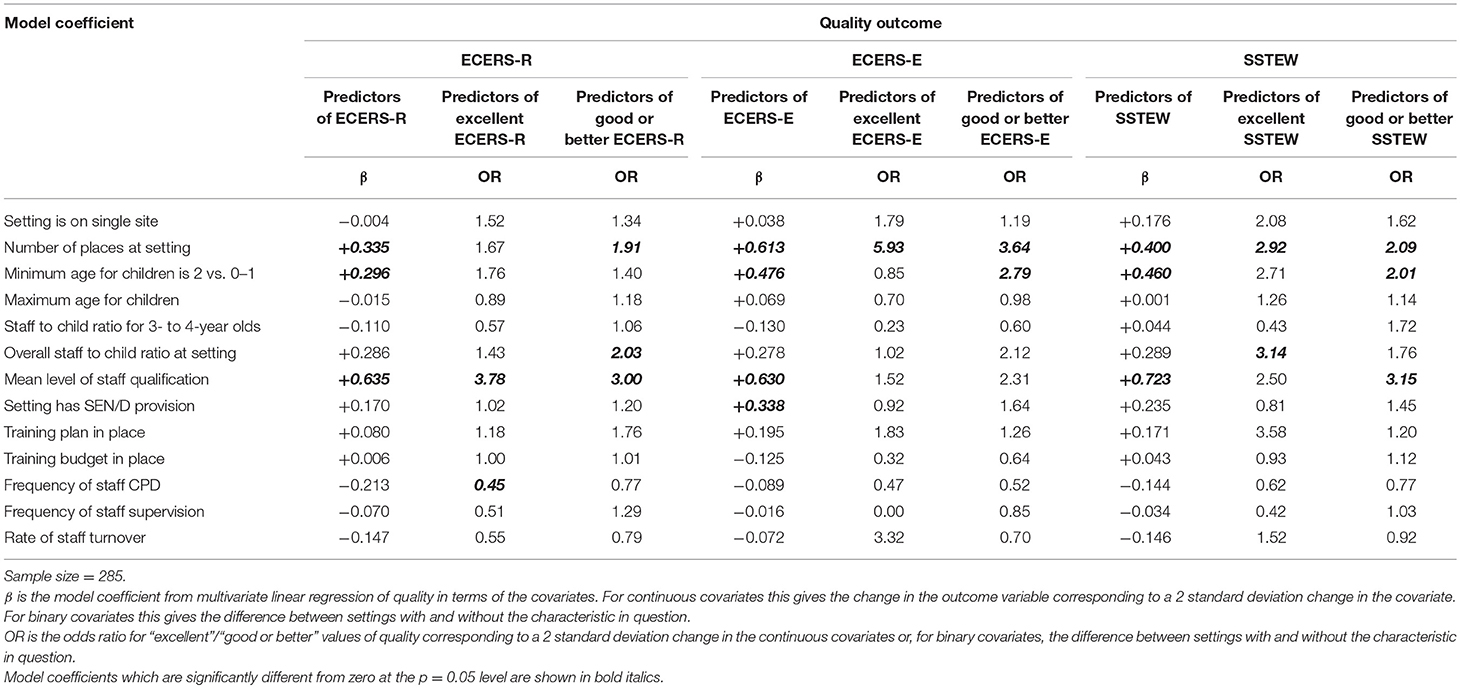
Table 4. Results of regression models of quality in terms of structural characteristics; private settings.
In private settings, there were significant associations between higher quality on the ECERS-R, ECERS-E and SSTEW scales and having a larger number of places, a higher mean level of staff qualification and a minimum age of 2 for children. Having SEN/D provision was significantly associated with higher ECERS-E scores. Achieving excellence on the ECER-R scale was associated with a higher mean level of staff qualification and a lower frequency of staff CPD. Larger settings (settings with a larger number of places) were associated with higher likelihood of achieving excellent ECERS-E scores, whilst excellent SSTEW scores were associated with larger settings and a higher overall staff to child ratio. Larger settings were associated with a higher likelihood of achieving “good or better” scores on all three quality scales. A minimum age of 2 for children was associated with “good or better” scores on the ECERS-E and SSTEW scales, a higher mean level of staff qualification was associated with achieving “good or better” scores on the ECERS-R and SSTEW scales; a higher overall staff to child ratio was associated with achieving “good or better” ECERS-R scores; see Table 4.
In voluntary settings, having a training plan in place and a higher overall staff to child ratio were associated with higher scores on the ECERS-R scale. Having a higher staff to child ratio (i.e., fewer children per member of staff) was associated with higher scores on the ECER-E scale. Having a training plan in place was also associated with higher SSTEW scores. Not having SEN/D provision was associated with an increased probability of achieving excellent ECERS-R scores. A higher staff to child ratio and a minimum age of 0–1 for children were associated with an increased probability of achieving “good or better” ECERS-E scores. Finally, having a training plan in place was associated with an increased probability of achieving “good or better” SSTEW scores; see Table 5.
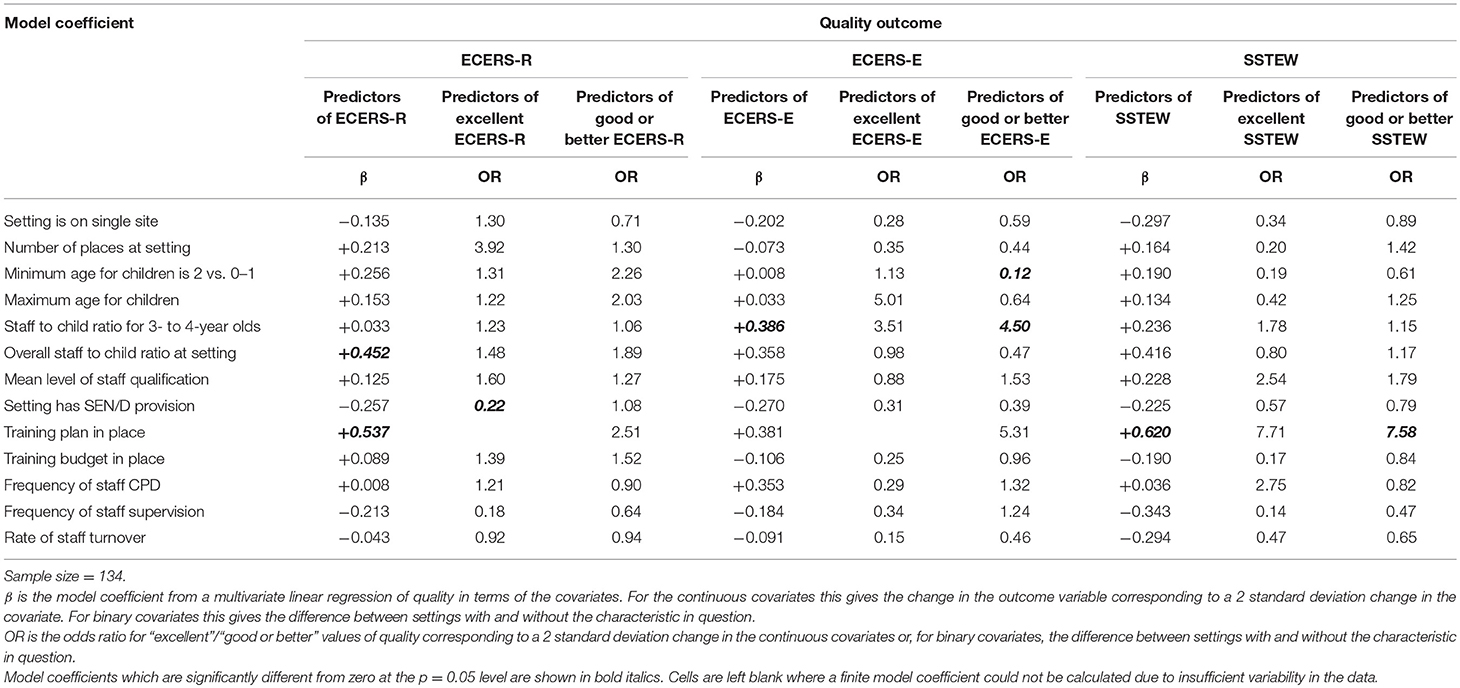
Table 5. Results of regression models of quality in terms of structural characteristics; voluntary settings.
For nursery classes/schools a lower maximum age for children was associated with higher ECERS-R and ECERS-E scores; having a training budget in place was associated with higher ECERS-E and SSTEW scores and a lower rate of staff turnover was associated with having higher SSTEW scores; see Table 6.
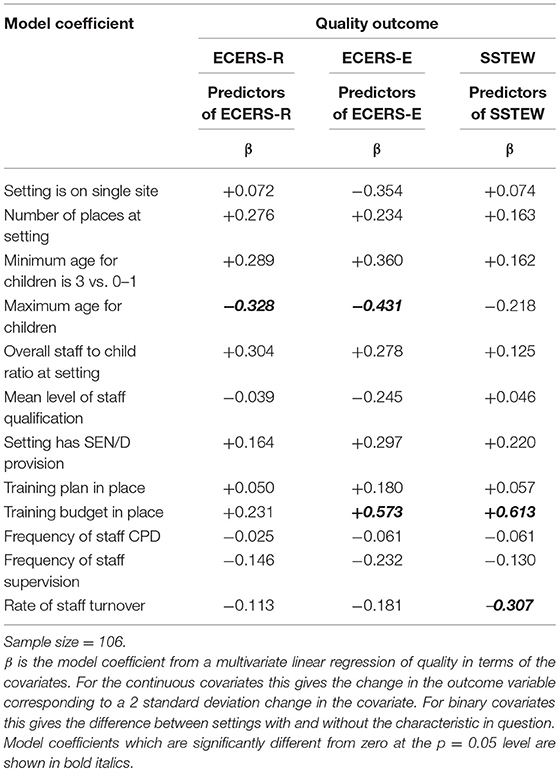
Table 6. Results of regression models of quality in terms of structural characteristics; nursery classes/schools.
For children's centres a higher mean level of staff qualification was associated with achieving higher scores on the ECERS-R scale; see Table 7.
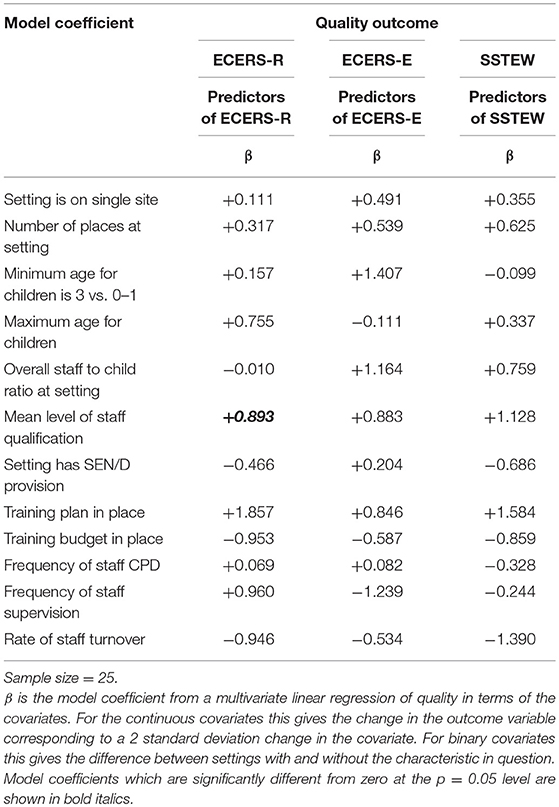
Table 7. Results of regression models of quality in terms of structural characteristics; children's centres.
Results of the Comparison Between SEED and EPPE
The ECERS-R and ECERS-E quality scores were compared for the SEED and the earlier EPPE samples overall. The mean ECERS-R score (overall quality) for settings in the EPPE study was 4.29, compared to a mean of 5.28 in SEED. For ECERS-E the mean for EPPE was 3.17 whilst the mean for SEED was 4.18. A comparison of these scores by category is given in Figure 1 (ECERS-R) and Figure 2 (ECERS-E). There is a greater proportion of poorer quality settings (i.e., inadequate, minimal, and adequate) in the EPPE study than in the SEED study for both ECERS-R and ECERS-E. This indicates that the quality of ECEC settings in England on these measures has improved between the time of EPPE and the time of SEED.
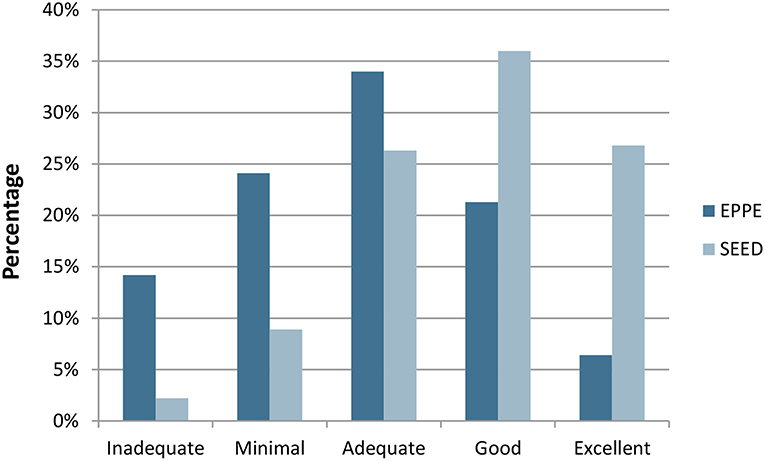
Figure 1. Percentage breakdown of ECERS-R scores by quality level in the EPPE and SEED studies. Quality is classified as Inadequate (<3), minimal (≥3 and <4), adequate (≥4 and <5), good (≥5 and <6) or excellent (≥6). Figure © 2017 NatCen Social Research, University of Oxford and Action for Children, reproduced with permission.
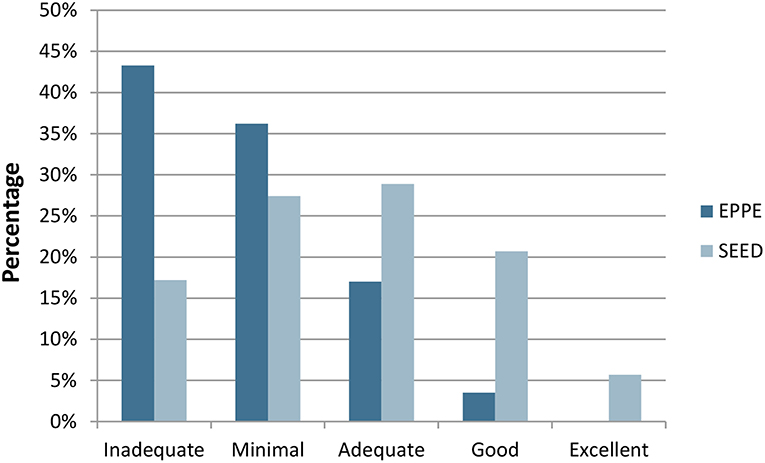
Figure 2. Percentage breakdown of ECERS-E scores by quality level in the EPPE and SEED studies. Quality is classified as Inadequate (<3), minimal (≥3 and <4), adequate (≥4 and <5), good (≥5 and <6) or excellent (≥6). Figure © 2017 NatCen Social Research, University of Oxford and Action for Children, reproduced with permission.
From the staff interviews carried out by both studies, comparable data on staff qualifications were derived. The qualification levels of both managers and staff at ECEC settings increased between the EPPE interviews in 1998–1999 (Taggart et al., 2000) and the SEED interviews in 2014–2016 (Melhuish and Gardiner, 2018). A comparison of manager's highest qualification between the EPPE and SEED studies is shown in Figure 3. The percentage of managers with a degree (Level 5 or above) rose from 43% in the EPPE study to 66% in the SEED study. Comparing the mean level of staff qualification (see Figure 4), we see that the most common level was 3–4 in both the SEED and EPPE studies; the second most common level for EPPE was a Level 2, whilst for SEED it was a Level 5 or above. It seems likely that the rise in ECEC quality between EPPE (1998–1999) and SEED (2014–2016) is partly due to the improvements in the qualification levels of staff and managers over this period.
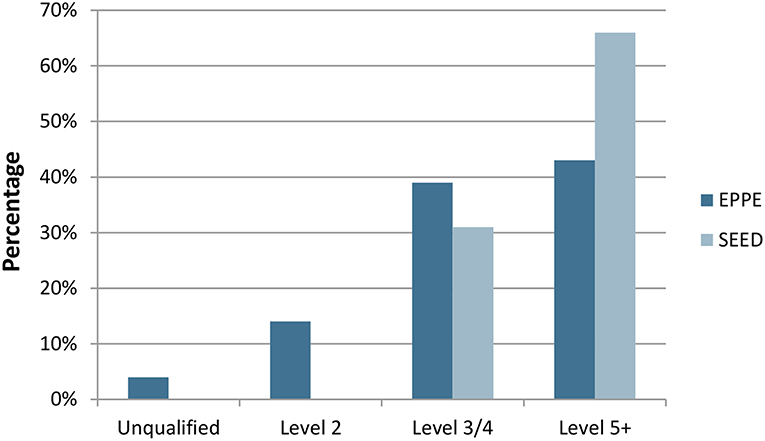
Figure 3. Comparison of level of manager's qualification in the EPPE and SEED studies. Figure © 2017 NatCen Social Research, University of Oxford and Action for Children, reproduced with permission.
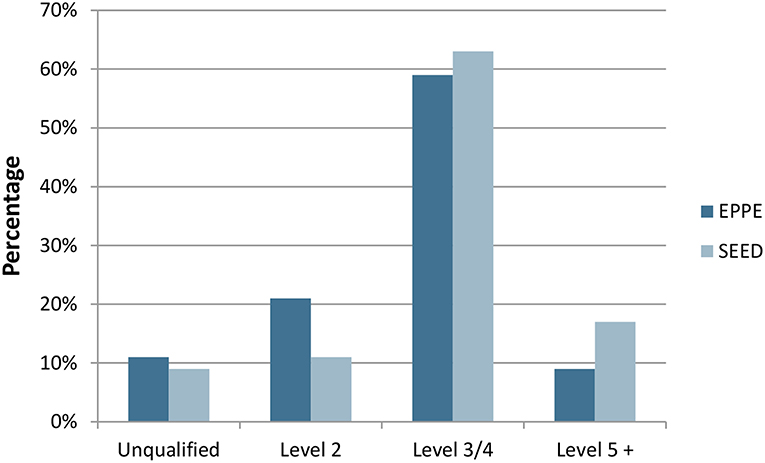
Figure 4. Comparison of level of staff qualification in the EPPE and SEED studies. Figure © 2017 NatCen Social Research, University of Oxford and Action for Children, reproduced with permission.
Discussion
Factors Associated With Process Quality
In line with previous research (Sylva et al., 1999b; Roberts et al., 2010; Brind et al., 2014; Ofsted, 2015), quality was found to vary by type of setting, with nursery classes/schools and children's centres tending to have higher process quality than the private and voluntary settings, which made up the majority of ECEC provision.
This study also found a wide ranging pattern of associations between the structural characteristics of ECEC settings and their process quality, which are relevant to policy development. As with any observational study, it cannot be assumed that these associations are causal, nor can it be assumed that, if they are causal, the direction of causation necessarily runs from structural characteristics to process quality. In some cases it is possible that causation could go in the other direction; for example, it could be that the associations between higher levels of staff qualification and higher process quality arise because higher quality settings are more successful in recruiting more highly qualified staff. There may also be unobserved confounding factors, which influence both structural characteristics and process quality. Nevertheless, it is cautiously suggested that the best explanation for the observed associations is mainly a causal one from structural characterizes to process quality, so that over time improving factors such as staff qualification levels and staff to child ratios would tend to result in improvements in ECEC settings quality.
There were some differences depending on the way that centres were funded and managed. It appears that staff qualification level was a significant driver of quality at private ECEC settings, which is in accord with existing research (Sylva et al., 1999b; Melhuish et al., 2006; Mathers et al., 2007; Roberts et al., 2010; Karemaker et al., 2011) For voluntary (not for profit) settings, which may be more homogenous in the level of staff and manager qualifications, the presence of a training plan was a significant predictor of higher quality. In line with earlier studies, a higher staff to child ratio was found to be a significant predictor of quality (Mathers et al., 2007; Roberts et al., 2010; Karemaker et al., 2011). However, it should be noted that state funded and managed nursery classes/schools, which tend to have lower staff to child ratios than private and voluntary settings, also tended to have higher process quality ratings. It may be that the presence of more highly qualified staff and managers allows quality to be maintained with a larger number of children per staff member. In a number of cases a narrower range of child ages was associated with higher quality provision, although this finding was not uniform since in voluntary settings for 3–4 year olds an increased probability of achieving “good or better” curriculum quality was associated with settings having a younger starting age for children. This is an area which may merit further study. At private settings for 3–4 year olds, excellence on the ECER-R scale was associated with a lower frequency of staff professional development (CPD). It is probable that this is an instance of reverse causation. That is, those settings that are seeking to improve have increased their frequency of CPD whilst those that have already achieved high quality standards have not needed to do so.
Changes Over Time Between the EPPE and SEED Studies
The EPPE (1998–1999) and the SEED (2014–2016) samples of ECEC settings were approximately representative of the early years sector at the time of the studies. The increase in quality between the EPPE and SEED studies over more than a decade on both the overall quality (ECERS-R) and curriculum quality (ECERS-E) is striking, during which time period there was a strong policy focus on increasing both the quantity and the quality of provision. This trend of increasing quality over time is in line with observations by the national organization responsible for assuring quality in the UK (Ofsted). The proportion of ECEC providers they judged to be good or outstanding increased from 74% in 2012 to 93% in 2017 (Ofsted, 2017), although it should be borne in mind that the validated quality measures used in the EPPE and SEED studies and the criteria used by Ofsted are significantly different. An increase in the qualification level for both setting managers and staff was also observed between the EPPE project and the SEED study. This is in line with evidence from the UK Labor Force Survey, which covers a similar period of time (Simon et al., 2016) It is probable that this increase is related to the rise in quality levels.
During the period of time between the two studies, raising staff and manager qualifications and facilitating in-service professional development have featured in government policy initiatives. These factors are likely to increase quality according to the analyses of structural factors as predictors of quality. Hence these findings may indicate that the increasing professionalization of the ECEC workforce as well as influencing qualification guidelines in the early years statutory framework, as elements of the policy change over the period, are factors in the observed change in ECEC quality in the approximately 15 years between the EPPE and SEED studies.
The improvement in quality seen between the time of the EPPE and SEED study is linked to a reduction in the incidence of poor quality and a corresponding increase in medium and high quality. This is relevant to future research that explores the relationship between ECEC quality and child development. Previously, where studies have found effects upon child outcomes linked to quality the studies have typically included ECEC centres that vary substantially across the quality range including substantial amounts of poor quality. Much of the effect upon outcomes in such studies (Sammons et al., 2002; Burchinal et al., 2008; Mashburn et al., 2008; Broekhuizen et al., 2015) derives from the poorer outcomes associated with poor quality as compared with medium to high quality. The consequence therefore of reducing the prevalence of poor quality is likely to be that quality effects upon child outcomes will be reduced and potentially be too small to be systematically of statistical significance in situations where there are a large number of covariates that are associated with powerful effects upon child outcomes. In such circumstances a study may conclude that there are no quality effects upon child outcomes, and this message may be seized upon by those (e.g., politicians) eager to reduce expenditure on maintaining good quality ECEC provision. Hence there is a socio-political danger inherent in the interpretation of a study's results without reference to the larger context of research.
Burchinal (2017) has referred to the reducing size of quality effects in more recent studies and possible reasons given are the reducing incidence of poor quality ECEC, and the inability of existing measures to adequately capture the aspects of ECEC most likely to influence child outcomes. This latter reason was the motivation behind the production of the Sustained Shared Thinking and Emotional Well-being (SSTEW) scale (Siraj et al., 2015) that focuses specifically on interactional quality likely to enhance language development and self-regulation, which have been linked with better long-term educational and socio-emotional outcomes (Malecki and Elliot, 2002; Trentacosta and Shaw, 2009; Moffitt et al., 2013). Further work is needed in improving ECEC quality measures, including both interactional and pedagogical aspects of quality.
Educational and Policy Implications
It is increasingly clear that ECEC is a substantial contributor to the longer-term educational, social and economic success of individuals (Heckman, 2008; Melhuish et al., 2015). Hence, if a country improves ECEC quality for its children then it is not only enhancing children's lives in the “here and now” it is also advancing the long-term outcomes for children, and by doing so it is investing in the future. In the current study staff qualifications were predictive of quality at private (for profit) settings, whilst for voluntary (not for profit) settings, which were rather homogenous in staff qualifications, having a staff training plan (in-service professional development) and a better staff to child ratio were predictive of higher quality. However, state funded ECEC centres, which tend to have less favorable staff to child ratios but more highly qualified staff than private and voluntary settings, tended to have higher quality. This indicates that the presence of more highly qualified staff may be more influential on quality than the staff: child ratio, at least within the range of these variables found in the UK. Earlier findings in the UK from the EPPE study led to an increased policy emphasis on improving ECEC quality through improving staff qualifications and training (Melhuish, 2016). This change in policy seems to have borne fruit in that a comparison of equivalent quality data from separate UK studies, conducted before and after this period of policy change, found improvement both in observed quality and staff qualifications, as reported in the current study. Overall these findings indicate that countries wishing to improve the quality of their ECEC provision should actively seek to improve both staff qualifications and in-service professional development. The potential for in-service professional development to improve ECEC quality is further supported by a recent RCT study in Australia (Siraj et al., 2018) where in-service professional development had clear effects upon observed quality in ECEC as well as potential effects for child outcomes. Hence it would be appropriate for policy in this area to be framed to increase staff qualifications and to provide enhanced opportunities for ECEC staff to obtain in-service professional development. Additionally, staff: child ratios should be maintained at as favorable a level as is pragmatically viable.
Conclusion
Structural aspects of quality such as staff qualifications and continuous professional development as well as staff:child ratios are linked to process quality in group ECEC settings. The 20 years since the start of the EPPE study have seen great changes in the level of use of ECEC in the UK and in the nature of the ECEC provided, to a large extent because of changes in government policy. The quality of ECEC provision has risen significantly over this period, as has the typical level of qualification of staff and managers. The almost universal use of ECEC, for 3–4 year olds in the UK, and other countries, makes the effectiveness of the provision crucial for children's later development. Whilst some of the factors that produce high quality ECEC are clear, well qualified staff/managers and adequate staff to child ratios being the best attested, this is an area where further research is still needed. However, the lessons from these two UK longitudinal studies provide an important indication for other countries about ways that child development may be enhanced through policy change, contributing to improvements in child well-being and later adult development.
Ethics Statement
Ethics approval was given by the University of Oxford ethics committee. Written informed consent was obtained from all adult study participants and from the parents/legal guardians of all non-adult participants.
Author Contributions
EM proposed the research hypotheses. JG carried out the data analysis. Both authors contributed to the writing of the paper and approved it for publication.
Conflict of Interest Statement
The authors declare that the research was conducted in the absence of any commercial or financial relationships that could be construed as a potential conflict of interest.
References
Almas, A. N., Grusec, J. E., and Tackett, J. L. (2011). Children's disclosure and secrecy: links to maternal parenting characteristics and children's coping skills. Soc. Dev. 20, 624–643. doi: 10.1111/j.1467-9507.2010.00602.x
Barnes, J., and Melhusih, E. (2016). Amount and timing of group-based childcare from birth and cognitive development at 51 months: a UK study. Int. J. Behav. Dev. 41, 360–370. doi: 10.1177/0165025416635756
Barnett, W. S. (2008). Preschool Education and its Lasting Effects: Research and Policy Implications. New Brunswick, NJ: National Institute for Early Education Research, Rutgers University.
Belsky, J. (1997). Theory testing, effect-size evaluation, and differential susceptibility to rearing influence: the case of mothering and attachment. Child Dev. 68, 598–600. doi: 10.1111/j.1467-8624.1997.tb04221.x
Bierman, K. L., Nix, R. L., Heinrichs, B. S., Domitrovich, C. E., Gest, S. D., Welsh, J. A., et al. (2014). Effects of head start REDI on children's outcomes 1 year later in different kindergarten contexts. Child Dev. 85, 140–159. doi: 10.1111/cdev.12117.
Brind, R., McGinigal, S., Lewis, J., and Ghezelayagh, S. (2014). Childcare and Early Years Providers Survey 2013. London: Department for Education.
Broekhuizen, M. L., Aken, M. A. G., Dubas, J. S., Mulder, H., and Leseman, P. P. (2015). Individual differences in effects of child care quality: The role of child affective self-regulation and gender. Infant. Behav. Dev. 40, 216–230. doi: 10.1016/j.infbeh.2015.06.009
Broekhuizen, M. L., van Aken, M. A. G., Dubas, J. S., and Leseman, P. P. M. (2014). Effects of Center-Based Child Care Quality on Child Socio-Emotional Outcomes: Does Quantity of Care Matter? Available online at: http://ecec-care.org/fileadmin/careproject/Presentations/Jyvaskyla_08_2014/effects_of_early_child_care_quality_on_child_socio-emotional_outcomes_does_quantity_matter.pdf (accessed April 15, 2019).
Burchinal, M. (2017). Measuring early care and education quality. Child Dev. Perspect. 12, 3–9. doi: 10.1111/cdep.12260
Burchinal, M., Howes, C., Pianta, R., Bryant, D., Early, D., Clifford, R., et al. (2008). Predicting child outcomes at the end of kindergarten from the quality of pre-kindergarten teacher-child interactions and instruction. Appl. Dev. Sci. 12, 140–153. doi: 10.1080/10888690802199418
Clifford, R. M., and Reszka, S. S. (2010). Reliability and Validity of the Early Childhood Environment Rating Scale. Available online at: http://ers.fpg.unc.edu/sites/ers.fpg.unc.edu/files/ReliabilityEcers.pdf
Department for Education (2014). Statutory Framework for the Early Years Foundation Stage. Setting the Standards for Learning, Development and Care for Children from Birth to Five. London: Department for Education.
Deynoot-Schaub, M. J. G., and Riksen-Walraven, J. M. (2006). Peer contacts of 15-month-olds in childcare: links with child temperament, parent–child interaction and quality of childcare. Soc. Dev. 15, 709–729. doi: 10.1111/j.1467-9507.2006.00366.x
Early, D. M., Maxwell, K. L., Burchinal, M., Alva, S., Bender, R. H., Bryant, D., et al. (2007). Teachers' education, classroom quality, and young children's academic skills: results from seven studies of preschool programs. Child Dev. 78, 558–580. doi: 10.1111/j.1467-8624.2007.01014.x
Harms, T., Cryer, D., and Clifford, R. M. (2005). Early Childhood Environment Rating Scale: Revised Edition. New York, NY: Teachers College Press.
Heckman, J. J. (2008). Schools, skills, and synapses. Econ. Inq. 46, 289–324. doi: 10.1111/j.1465-7295.2008.00163.x
Karemaker, A., Mathers, S., Hall, J., Sylva, K., and Clemens, S. (2011). Evaluation of the Graduate Leader Fund: Factors Relating to Quality: Findings From the Baseline Study. London: Department for Education.
Landry, S. H., Zucker, T. A., Taylor, H. B., Swank, P. R., Williams, J. M., Assel, M., et al. (2014). Enhancing early child care quality and learning for toddlers at risk: the responsive early childhood program. Dev. Psychol. 50:526. doi: 10.1037/a0033494
Love, J. M., Kisker, E. E., Ross, C., Raikes, H., Constantine, J., Boller, K., et al. (2005). The effectiveness of early head start for 3-year-old children and their parents: lessons for policy and programs. Dev. Psychol. 41, 885–901. doi: 10.1037/0012-1649.41.6.885
Malecki, C. K., and Elliot, S. N. (2002). Children's social behaviors as predictors of academic achievement: a longitudinal analysis. School Psychol. Quart. 17, 1–23. doi: 10.1521/scpq.17.1.1.19902
Manning, M., Homel, R., and Smith, C. (2010). A meta-analysis of the effects of early developmental prevention programs in at-risk populations on non-health outcomes in adolescence. Child. Youth Serv. Rev. 32, 506–519. doi: 10.1016/j.childyouth.2009.11.003
Mashburn, A. J., Pianta, R. C., Hamre, B. K., Downer, J. T., Barbarin, O. A., Bryant, D., et al. (2008). Measures of classroom quality in prekindergarten and children's development of academic, language, and social skills. Child Dev. 79, 732–749. doi: 10.1111/j.1467-8624.2008.01154.x
Mathers, S., Sylva, K., and Joshi, H. (2007). Quality of Childcare Settings in the Millennium Cohort Study. London.
McLaughlin, A. E., Campbell, F. A., Pungello, E. P., and Skinner, M. (2007). Depressive symptoms in young adults: the influences of the early home environment and early educational child care. Child Dev. 78, 746–756. doi: 10.1111/j.1467-8624.2007.01030.x
Melhuish, E. (2004). A Literature Review of the Impact of Early Years Provision on Young Children, With Emphasis Given to Children From Disadvantaged Backgrounds. London: Department for Education.
Melhuish, E. (2016). Longitudinal research and early years policy development in the UK. Int. Child Care Edu. Policy 10:3. doi: 10.1186/s40723-40016-40019-40721.
Melhuish, E., Ereky-Stevens, K., Petrogiannis, K., Ariescu, A., Penderi, E., Rentzou, K., et al. (2015). A Review of Research on the Effects of Early Childhood Education and Care (ECEC) Upon Child Development. CARE project; curriculum quality analysis and impact review of European early childhood education and care (ECEC). Technical Report. Available online at: http://ecec-care.org/resources/publications/
Melhuish, E., and Gardiner, J. (2018). Study of Early Education and Development (SEED): Study of Quality of Early Years Provision in England. London: Department for Education.
Melhuish, E., Gardiner, J., and Morris, S. (2017). Study of Early Education and Development (SEED): Impact Study on Early Education Use and Child Outcomes Up to Age Three. London: Department for Education.
Melhuish, E., Quinn, L., Hanna, K., Sylva, K., Siraj-Blatchford, I., Sammons, P., et al. (2006). The Effective Pre-school Provision in Northern Ireland Project. Summary Report. Belfast, NI: Department of Education.
Moffitt, T., Poulton, R., and Caspi, A. (2013). Lifelong impact of early self-control. Am. Sci. 101, 352–359. doi: 10.1511/2013.104.1
Muennig, P., Robertson, D., Johnson, G., Campbell, F., Pungello, E. P., and Neidell, M. (2011). The effect of an early education program on adult health: the Carolina Abecedarian Project randomized controlled trial. Am. J. Public Health. 101, 512–516. doi: 10.2105/AJPH.2010.200063
NICHD Early Child Care Research Network (2006). Child-care effect sizes for the NICHD study of early child care and youth development. Am. Psychol. 61, 99–116. doi: 10.1037/0003-066X.61.2.99
OECD (2017). Starting Strong 2017: Key OECD Indicators on Early Childhood Education and Care. Paris. Available onlinne at: http://doi.org/10.1787/9789264276116-en
Ofsted (2015). The Report of Her Majesty's Chief Inspector of Education, Children's Services and Skills 2015: Early years. Manchester: Ofsted.
Peisner-Feinberg, E. S., Burchinal, M. R., Clifford, R. M., Culkin, M. L., Howes, C., Kagan, S. L., et al. (2001). The relation of preschool child-care quality to children's cognitive and social developmental trajectories through second grade. Child Dev. 72, 1534–1553. doi: 10.1111/1467-8624.00364
Phillips, D., Crowell, N. A., Sussman, A. L., Gunnar, M., Fox, N., Hane, A. A., et al. (2012). Reactive temperament and sensitivity to context in childcare. Soc. Dev. 21, 628–643. doi: 10.1111/j.1467-9507.2011.00649.x
Pluess, M., and Belsky, J. (2009). Differential susceptibility to rearing experience: the case of childcare. J. Child Psychol. Psych., 50, 396–404. doi: 10.1111/j.1469-7610.2008.01992.x
Reynolds, A. J., Temple, J. A., Ou, S.-R., Arteaga, I. A., and White, B. A. (2011). School-based early childhood education and age-28 well-being: effects by timing, dosage, and subgroups. Science 333, 360–364. doi: 10.1126/science.1203618
Roberts, F., Mathers, S., Joshi, H., Sylva, K., and Jones, E. (2010). “Childcare in the pre-school years,” in Children of the 21st Century: The First Five Years, eds K. Hansen, H. Joshi, and S. Dex (Bristol: The Policy Press), 131–151.
Sammons, P., Sylva, K., Melhuish, E., Taggart, B., Elliot, K., and Siraj-Blatchford, I. (2002). The Effective Provision of Pre-School Education (EPPE) Project: Measuring the Impact of Pre-School on Children's Cognitive Progress Over the Pre-School Period. London: Department for Education.
Simon, A., Owen, C., and Hollingworth, K. (2016). Is the ‘quality' of preschool childcare, measured by the qualifications and pay of the childcare workforce, improving in Britain? Am. J. Edu. Res. 4, 11–17. doi: 10.12691/education-4-1-4
Siraj, I., Kingston, D., and Melhuish, E. (2015). Assessing Quality in Early Childhood Education and Care: Sustained Shared Thinking and Emotional Well-Being (SSTEW) Scale for 2–5-Year-Olds Provision. London: Trentham Books.
Siraj, I., Melhuish, E., Howard, S. J., Neilsen-Hewett, C., Kingston, D., de Rosnay, M., et al. (2018). Fostering Effective Early Learning (FEEL) Study. Sydney: NSW Department of Education. Available online at: https://education.nsw.gov.au/early-childhood-education/whats-happening-in-the-early-childhood-education-sector/data-and-research/feel-study-2018
Slot, P. L., Leseman, P. P. M., Verhagen, J., and Mulder, H. (2015). Associations between structural quality aspects and process quality in Dutch early childhood education and care settings. Early Child. Res. Quart. 33, 64–76. doi: 10.1016/j.ecresq.2015.06.001
Sylva, K., Melhuish, E., Sammons, P., Siraj, I., and Taggart, B. (2004). The Effective Provision of Pre-School Education (EPPE) Project: Technical Paper 12 - The Final Report: Effective Pre-School Education. London: Department for Education.
Sylva, K., Melhuish, E., Sammons, P., and Siraj-Blatchford, I. (2010). Early Childhood Matters: Evidence From the Effective Pre-school and Primary Education Project. London: Routledge.
Sylva, K., Melhuish, E., Sammons, P., Siraj-Blatchford, I., and Taggart, B. (2008). Final Report From the Primary Phase: Pre-school, School and Family Influences on Children's Development During Key Stage 2 (7–11). Nottingham: Department for Children, Schools and Families.
Sylva, K., Siraj-Blatchford, I., Melhuish, E., Sammons, P., and Taggart, B. (1999a). The Effective Provision of Pre-School Education (EPPE) Project. Technical Paper 6A: Characteristics of Pre-school environments, London.
Sylva, K., Siraj-Blatchford, I., Melhuish, E., Sammons, P., Taggart, B., Evans, E., et al. (1999b). The Effective Provision of Pre-school Education Project. Technical Paper 6: Characteristics of the centres in the EPPE sample: Observational Profiles, London.
Sylva, K., Siraj-Blatchford, I., and Taggart, B. (2011). ECERS-E The Four Curricular Subscales Extension to the Early Childhood Environment Rating Scale, 4th Edn. New York, NY: Teachers College Press.
Taggart, B., Melhuish, E. C., Siraj-Blatchford, I., Sylva, K., and Sammons, P. (2000). The Effective Provision of Pre-school Education Project, Technical Paper 5: Report on Pre-school Centre Characteristics. London: Institute of Education/DfE.
Trentacosta, C. J., and Shaw, D. S. (2009). Emotional self-regulation, peer rejection and antisocial behavior: developmental associations from early childhood to early adolescence. J. Appl. Dev. Psychol. 30, 356–365. doi: 10.1016/j.appdev.2008.12.016
Vandell, D. L., Belsky, J., Burchinal, M., Steinberg, L., and Vandergrift, N. (2010). Do effects of early child care extend to age 15 years? Results from the NICHD study of early child care and youth development. Child Dev. 81, 737–756. doi: 10.1111/j.1467-8624.2010.01431.x
Votruba-Drzal, E., Coley, R. L., and Chase-Lansdale, P. L. (2004). Child care and low-income children's development: direct and moderated effects. Child Dev. 75, 296–312. doi: 10.1111/j.1467-8624.2004.00670.x
Votruba-Drzal, E., Coley, R. L., Maldonado-Carreño, C., Li-Grining, C. P., and Chase-Lansdale, P. L. (2010). Child care and the development of behavior problems among economically disadvantaged children in middle childhood. Child Dev. 81, 1460–1474. doi: 10.1111/j.1467-8624.2010.01485.x
Whitebread, D., Kuvalja, M., and O'Connor, A. (2015). Quality in Early Childhood Education: an International Review and Guide for Policy Makers. WISE Initiative, Cambridge: University of Cambridge. Available online at: http://www.wise-qatar.org/sites/default/files/asset/document/wise-research-7-cambridge-11_17.pdf
Keywords: early childhood education and care (ECEC), preschool, policy change, early years educational policy, early years and leadership
Citation: Melhuish E and Gardiner J (2019) Structural Factors and Policy Change as Related to the Quality of Early Childhood Education and Care for 3–4 Year Olds in the UK. Front. Educ. 4:35. doi: 10.3389/feduc.2019.00035
Received: 12 July 2018; Accepted: 09 April 2019;
Published: 07 May 2019.
Edited by:
Douglas F. Kauffman, Medical University of the Americas–Nevis, United StatesReviewed by:
Virginia Tompkins, The Ohio State University at Lima, United StatesEmily Tomayko, Oregon State University, United States
Pablo Fernández-Berrocal, University of Málaga, Spain
Copyright © 2019 Melhuish and Gardiner. This is an open-access article distributed under the terms of the Creative Commons Attribution License (CC BY). The use, distribution or reproduction in other forums is permitted, provided the original author(s) and the copyright owner(s) are credited and that the original publication in this journal is cited, in accordance with accepted academic practice. No use, distribution or reproduction is permitted which does not comply with these terms.
*Correspondence: Edward Melhuish, ZWR3YXJkLm1lbGh1aXNoQGVkdWNhdGlvbi5veC5hYy51aw==
 Edward Melhuish1,2*
Edward Melhuish1,2* Julian Gardiner
Julian Gardiner